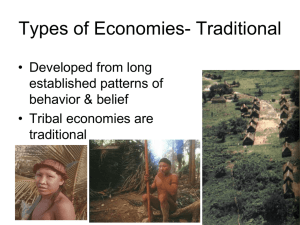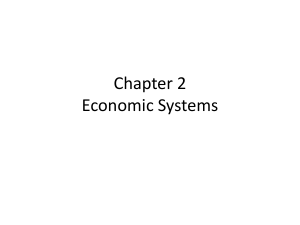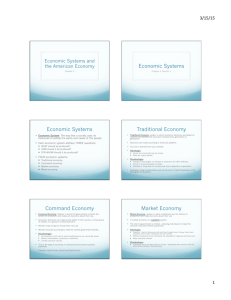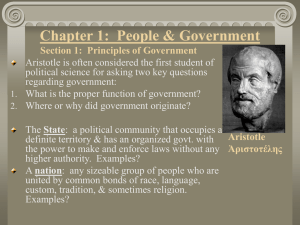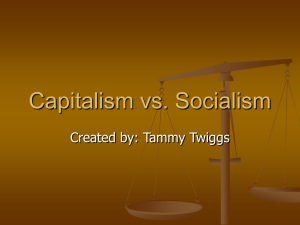File
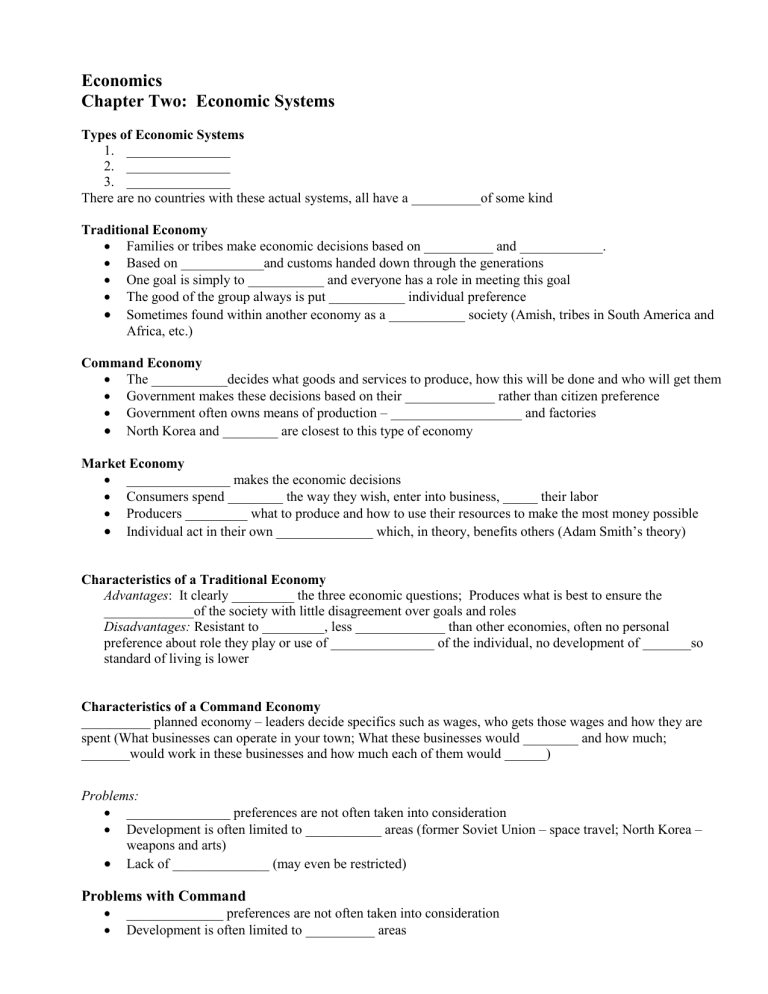
Economics
Chapter Two: Economic Systems
Types of Economic Systems
1.
_______________
2.
_______________
3.
_______________
There are no countries with these actual systems, all have a __________of some kind
Traditional Economy
Families or tribes make economic decisions based on __________ and ____________.
Based on ____________and customs handed down through the generations
One goal is simply to ___________ and everyone has a role in meeting this goal
The good of the group always is put ___________ individual preference
Sometimes found within another economy as a ___________ society (Amish, tribes in South America and
Africa, etc.)
Command Economy
The ___________decides what goods and services to produce, how this will be done and who will get them
Government makes these decisions based on their _____________ rather than citizen preference
Government often owns means of production – ___________________ and factories
North Korea and ________ are closest to this type of economy
Market Economy
_______________ makes the economic decisions
Consumers spend ________ the way they wish, enter into business, _____ their labor
Producers _________ what to produce and how to use their resources to make the most money possible
Individual act in their own ______________ which, in theory, benefits others (Adam Smith’s theory)
Characteristics of a Traditional Economy
Advantages : It clearly _________ the three economic questions; Produces what is best to ensure the
_____________of the society with little disagreement over goals and roles
Disadvantages: Resistant to _________, less _____________ than other economies, often no personal preference about role they play or use of _______________ of the individual, no development of _______so standard of living is lower
Characteristics of a Command Economy
__________ planned economy – leaders decide specifics such as wages, who gets those wages and how they are spent (What businesses can operate in your town; What these businesses would ________ and how much;
_______would work in these businesses and how much each of them would ______)
Problems:
_______________ preferences are not often taken into consideration
Development is often limited to ___________ areas (former Soviet Union – space travel; North Korea – weapons and arts)
Lack of ______________ (may even be restricted)
Problems with Command
______________ preferences are not often taken into consideration
Development is often limited to __________ areas
former Soviet Union – _______travel
North Korea – __________ and arts
Lack of ______________ (may even be restricted)
Characteristics of PURE Market
No _____________ regulation or involvement
Based only on _______/demand
Right to own property and make a_________
Right to __________ wealth
Disadvantages of Pure Market
No Government controls
_________ and corruption are not limited
______________concerns are not addressed
Working conditions and __________ pay are not priority
No way to provide public _________to those who cannot get them on their own
Tends to be a _____ in standard of living – “class” system can develop
Mixed Economies
Authoritarian Socialism
_______________
Democratic Socialism
Socialism with citizen input
_______________
Market with government control – the more control the government has, the closer it moves to socialism
Authoritarian Socialism
___________ to the pure command model
Often called _____________
Government __________all factors
Government often develops a long term plan for how ___________ are used and production is distributed -
Cuba
May have a ____________government - North Korea
May have elements of _______ types of economies - China
________________ answers the three questions (central planning)
Often a _________ or religious authority
People have ______ or no say in their economic lives
Examples:
North Korea (__________ to pure command): Some areas in Africa (tribal leaders); _________ nations; China
Problems with Authoritarian Socialism
Technological advancements are not encouraged except in the ________ areas (former Soviet Union and
_________travel)
All resources tend to be ______________in one area (North Korea – military related production)
Human rights are often _____ a priority (worker rights, reproductive rights, family choices, etc)
Democratic Socialism
_____of market and command
Government owns _______ factors of production
Often ___________ to utilities, telephone networks and natural resources
Control of these factors are often influenced by individuals through democratic ____________
May include a _________
Examples of Democratic Socialism in the United States
Control of banking industry through __________________
Infrastructure (bridges, roads, etc)
Military
______________
Police and Fire protection
Public Libraries
_________________ and Social Welfare Systems
Other Democratic Socialism Countries
Sweden, Poland, __________, Angola, Mozambique, Tanzania, _____________ (although also strong Capitalism)
Capitalism
___________ to Market
Individuals own the factors of production and answer the _________questions
Government does ___________ to prevent “market inequalities” such as:
Environmental Protection
Working Conditions and ________ rates
Product Safety
Problems with Capitalism
Tends to favor _____________over worker
Political _____________ over amount of government regulation (a key difference between Republicans and Democrats in our country)
Regulation limits corporate _________
Examples of Capitalism
United States,___________, Mexico, Japan
All of these have ______________ of Democratic Socialism – education, medical care (except US), natural resource management, etc.
Market Economies (Capitalism) - Fundamentals
Right to _______property
_____________government involvement – does not mean NO involvement – means government only steps in when and where necessary (example: economic crisis)
Voluntary exchange – buying and selling occurs because ________parties benefit
Specialization and Markets – people ________________ their efforts in the areas they do best (advantages)
Competition and Consumer Sovereignty – consumers are free to _______________ what they want
(ultimate control over what is produced)
Circular Flow of Free Market
Example – page 53
A circular flow model shows how the ____________ sectors relate to one another
The free market model shows ______________ between us (households) and businesses
This is divided into product market and ___________ market
Factors Market
Households sell their _____________ (particularly labor and entrepreneurship to businesses.)
In exchange for the resources, businesses pay ___________ to households
Product Market
Businesses ______ goods and services to households
Households send payments for goods and services to ____________. consumer spending and business revenue
Trends in Modern Economies
Changes in ownership
Moving toward a ____________or Capitalistic system often leads to privatization of resources (former
Soviet Union)
Moving toward ____________ or Authoritarian Socialism often leads to nationalization of resources
(Venezuela)
Economies are becoming more _________ in trade, business ownership, sharing of research and development expenses, etc
What type of economy do you have and WHY
Who owns and controls the natural and capital resources?
How are workers paid and how much independence do they have
Private ownership of businesses?
Elected Government in true elections?
